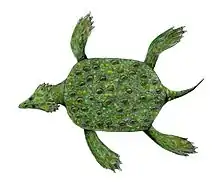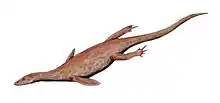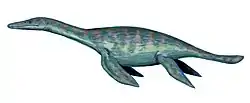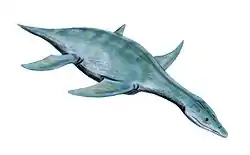Leivanectes
Leivanectes is a genus of plesiosaurs of the family Elasmosauridae known from Late Aptian marine deposits in central Colombia. It contains a single species, L. bernadoi, which was described in 2019.
| Leivanectes | |
|---|---|
| Scientific classification | |
| Kingdom: | Animalia |
| Phylum: | Chordata |
| Class: | Reptilia |
| Superorder: | †Sauropterygia |
| Order: | †Plesiosauria |
| Family: | †Elasmosauridae |
| Genus: | †Leivanectes Páramo Fonseca et al., 2019 |
| Species: | †L. bernardoi |
| Binomial name | |
| †Leivanectes bernardoi Páramo Fonseca et. al., 2019 | |
Description
Leivanectes differs from Callawayasaurus, which has been found in the same formation, in having fewer mandibular alveoli and a short mandibular symphysis with three alveoli (5 in Callawayasaurus).[1]
Distribution
Leivanectes remains have been found in the fossiliferous Paja Formation of the Altiplano Cundiboyacense, which crops out near Villa de Leyva, also written as Villa de Leiva, Boyaca, Colombia. The genus name refers to Villa de Leiva.[1]
References
- Páramo Fonseca, María Euridice; José Patricio O'Gorman; Zulma Gasparini; Santiago Padilla, and Mary Luz Parra Ruge. 2019. A new late Aptian elasmosaurid from the Paja Formation, Villa de Leiva, Colombia. Cretaceous Research in press. _. Accessed 2019-03-09.
This article is issued from Wikipedia. The text is licensed under Creative Commons - Attribution - Sharealike. Additional terms may apply for the media files.






.png.webp)


.jpg.webp)
